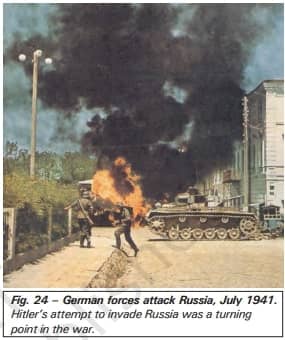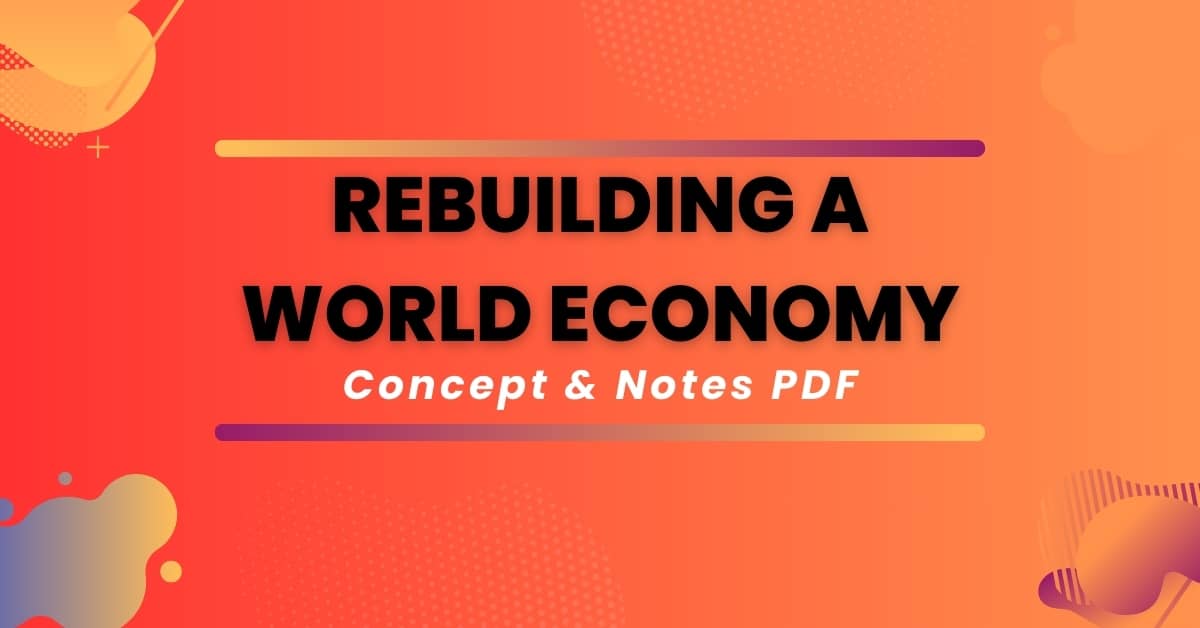Rebuilding a World Economy: The Post-war Era – Concept & Notes PDF for Free
Topic & sub-topics covered: Rebuilding a World Economy: The Post-war Era, Post-war Settlement and the Bretton Woods Institutions, The Early Post-war Years, Decolonisation and Independence, End of Bretton Woods and the Beginning of ‘Globalisation’: The Making of a Global World (All single detail notes that are exam-oriented).
We have discussed in-depth and exam-oriented pointers that can be asked in the board exam of class 10th about “Rebuilding a World Economy: The Post-war Era, Post-war Settlement and the Bretton Woods Institutions, The Early Post-war Years, Decolonisation and Independence, End of Bretton Woods and the Beginning of ‘Globalisation’” which is taken from the NCERT History book for class 10th chapter no. 3 “The Making of a Global World“.
Download NCERT History Chapter 3 Class 10th Notes PDF for Free The Making of a Global World
If you are in class 10th and looking for free NCERT History chapter 3 notes of chapter The Making of a Global World class 10 that cover concepts, then From here you can download the free class 10th History chapter 3 notes “The Making of a Global World”. You should download this free PDF for future test or exam preparations.
NCERT History Chapter 3 The Making of Global World Class 10 Notes
Rebuilding a World Economy: The Post-war Era

1. Second World War Overview:
- Broke out two decades after the First World War, fought between Axis powers (Germany, Japan, Italy) and Allies (Britain, France, Soviet Union, US).
- Six-year duration, involving multiple fronts – land, sea, and air.
2. Casualties and Destruction:
- Enormous death and destruction: Approximately 60 million people, 3% of the world’s 1939 population, were killed directly or indirectly.
- The majority of deaths occurred outside battlefields, impacting civilians more than soldiers.
- Extensive devastation in Europe and Asia, cities destroyed by aerial bombardment and artillery attacks.
3. Post-war Reconstruction Influences:
- US Emergence: The US emerged as the dominant economic, political, and military power in the Western world.
- Soviet Union Dominance: The Soviet Union, having made significant sacrifices to defeat Nazi Germany, transformed into a world power during the war.
4. Economic and Social Impact:
- The war caused immense economic devastation and social disruption globally.
- Reconstruction efforts were anticipated to be challenging and prolonged.
Understanding the significant influences on post-war reconstruction, especially the roles of the US and the Soviet Union, is crucial for exam preparation.
Post-war Settlement and the Bretton Woods Institutions
1. Lessons from Inter-War Economic Experiences:
a. First Lesson:
- An industrial society based on mass production needs mass consumption for sustainability.
- High and stable incomes are crucial for ensuring mass consumption.
- Stable incomes require steady, full employment.
b. Second Lesson:
- Governments need to intervene to minimize fluctuations in price, output, and employment.
- Market mechanisms alone cannot guarantee full employment.
2. Economic Links with the Outside World:
- Achievement of full employment requires government control over the flows of goods, capital, and labour.
- Government intervention is essential for economic stability.
3. Post-War International Economic System – Bretton Woods:
- Framework was established at the United Nations Monetary and Financial Conference in July 1944 at Bretton Woods, USA.
- Created the International Monetary Fund (IMF) to manage external surpluses and deficits.
- Established the International Bank for Reconstruction and Development (World Bank) for postwar reconstruction.
- Collectively referred to as the Bretton Woods institutions or twins.
4. Bretton Woods System – Characteristics:
- IMF and World Bank operations commenced in 1947.
- Western industrial powers, with the US having an effective right of veto, control decision-making.
- International monetary system based on fixed exchange rates.
- Currencies, like the Indian rupee, pegged to the dollar at fixed rates; the dollar anchored to gold at $35 per ounce.
Understanding the lessons drawn from the inter-war period and the establishment of the Bretton Woods system, along with its key components, is crucial for exam preparation.
The Early Post-war Years
1. Impact of the Bretton Woods System:
- Inaugurated an era of unprecedented growth in trade and incomes for Western industrial nations and Japan.
- Annual world trade growth exceeded 8% between 1950 and 1970.
- Incomes grew by nearly 5% during the same period.
- The growth was characterized by stability, with minimal large fluctuations.
2. Stability in Industrial Countries:
- Unemployment rates in most industrial countries averaged less than 5% for much of the period.
- Reflects the success of the Bretton Woods system in maintaining economic stability.
3. Global Spread of Technology and Enterprise:
- Developing countries were eager to catch up with advanced industrial nations.
- Massive capital investments were made to import industrial plants and equipment featuring modern technology.
- The era witnessed the widespread dissemination of technology and enterprise on a global scale.
Decolonisation and Independence
1. Post-WWII Decolonization:
- After WWII, most colonies in Asia and Africa gained independence from European colonial rule.
- The emergence of free, independent nations, faced challenges such as poverty and resource limitations.
- Economies and societies were impacted by the legacy of long periods of colonial rule.
2. Focus Shift of Bretton Woods Institutions:
- Initially designed for industrial countries, the IMF and World Bank shifted attention to developing countries in the late 1950s.
- Europe and Japan’s reduced dependence allowed the institutions to address the needs of developing nations.
3. Irony of Guidance and Control:
- Newly independent countries sought guidance from international agencies dominated by former colonial powers.
- Former colonial powers maintained control over vital resources like minerals and land in many ex-colonies.
4. Corporate Exploitation:
- Large corporations, especially from powerful countries like the US, secured rights to exploit natural resources in developing countries at low costs.
5. Group of 77 (G-77):
- Developing countries formed the Group of 77 to demand a New International Economic Order (NIEO).
- NIEO aimed for real control over natural resources, increased development assistance, fair prices for raw materials, and better market access for manufactured goods in developed countries.
End of Bretton Woods and the Beginning of ‘Globalisation’
1. US Financial Challenges:
- Despite stable growth, rising costs of overseas involvements weakened US finances and competitive strength.
- Confidence in the US dollar declined, leading to the collapse of fixed exchange rates and the adoption of floating exchange rates.
2. Shift in International Financial System (Mid-1970s):
- Developing countries turned to Western commercial banks instead of international institutions for loans.
- Resulted in periodic debt crises in developing nations, impacting incomes and increasing poverty, particularly in Africa and Latin America.
3. Rise in Unemployment (Mid-1970s to Early 1990s):
- Unemployment increased in the industrial world from the mid-1970s until the early 1990s.
4. MNCs’ Shift to Low-Wage Asian Countries (Late 1970s):
- Multinational Corporations (MNCs) relocated production operations to low-wage Asian countries, leading to a shift in global economic dynamics.
- China emerged as a significant destination due to its low-cost structure, especially low wages.
5. China’s Reintegration into the World Economy:
- China, previously isolated since the 1949 revolution, reintegrated into the global economy with new economic policies.
- The collapse of the Soviet Union and communism in Eastern Europe contributed to this reintegration.
6. Impact on World Trade and Capital Flows:
- Relocation of industries to low-wage countries, particularly China, stimulated world trade and capital flows.
- Economic transformation in countries like India, China, and Brazil reshaped the world’s economic geography.
Understanding the US financial challenges, the shift in the international financial system, the rise in unemployment, MNCs’ relocation to low-wage countries, China’s reintegration, and the impact on world trade is crucial for exam preparation.
Next & Previous Topics of NCERT/CBSE History Class 10 Chapter 3: The Making of a Global World
| Topics No. | Topics Name |
|---|---|
| 1 | The Pre-modern World |
| 2 | The Nineteenth Century (1815-1914) |
| 3 | The Inter-war Economy |
| 4 | Rebuilding a World Economy: The Post-war Era |

